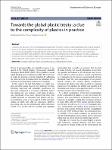Towards the global plastic treaty: a clue to the complexity of plastics in practice
| dc.contributor.author | Filella, M | |
| dc.contributor.author | Turner, A | |
| dc.date.accessioned | 2024-04-24T10:10:41Z | |
| dc.date.available | 2024-04-24T10:10:41Z | |
| dc.date.issued | 2023 | |
| dc.identifier.issn | 2190-4707 | |
| dc.identifier.issn | 2190-4715 | |
| dc.identifier.other | 99 | |
| dc.identifier.uri | https://pearl.plymouth.ac.uk/handle/10026.1/22301 | |
| dc.description.abstract |
Following the decision of the United Nations Environment Assembly (UNEA) to start negotiations for a legally binding treaty to end plastic pollution, discussions and reflections are ongoing on why and how plastic chemicals and polymers of concern should be integrated into the global plastics treaty. One of the points that has been identified as requiring attention is the reduction of the complexity of the composition of plastic objects. This article, addressed to decision-makers and other stake-holders involved in the negotiations, illustrates in a practical and graphical way what complexity means in the case of the presence of inorganic additives. | |
| dc.format.extent | 99- | |
| dc.language | en | |
| dc.publisher | Springer Science and Business Media LLC | |
| dc.subject | Inorganic additives | |
| dc.subject | Plastic consumer products | |
| dc.subject | Beached plastic litter | |
| dc.title | Towards the global plastic treaty: a clue to the complexity of plastics in practice | |
| dc.type | Journal Article | |
| plymouth.issue | 1 | |
| plymouth.volume | 35 | |
| plymouth.publication-status | Published online | |
| plymouth.journal | Environmental Sciences Europe | |
| dc.identifier.doi | 10.1186/s12302-023-00801-9 | |
| plymouth.organisational-group | |Plymouth | |
| plymouth.organisational-group | |Plymouth|Research Groups | |
| plymouth.organisational-group | |Plymouth|Faculty of Science and Engineering | |
| plymouth.organisational-group | |Plymouth|Faculty of Science and Engineering|School of Geography, Earth and Environmental Sciences | |
| plymouth.organisational-group | |Plymouth|Research Groups|Marine Institute | |
| plymouth.organisational-group | |Plymouth|REF 2021 Researchers by UoA | |
| plymouth.organisational-group | |Plymouth|Users by role | |
| plymouth.organisational-group | |Plymouth|Users by role|Current Academic staff | |
| plymouth.organisational-group | |Plymouth|Research Groups|BEACh | |
| plymouth.organisational-group | |Plymouth|REF 2021 Researchers by UoA|UoA07 Earth Systems and Environmental Sciences | |
| plymouth.organisational-group | |Plymouth|REF 2029 Researchers by UoA | |
| plymouth.organisational-group | |Plymouth|REF 2029 Researchers by UoA|UoA07 Earth Systems and Environmental Sciences | |
| dc.date.updated | 2024-04-24T10:10:41Z | |
| dc.rights.embargodate | 2024-04-27 | |
| dc.identifier.eissn | 2190-4715 | |
| rioxxterms.versionofrecord | 10.1186/s12302-023-00801-9 |


